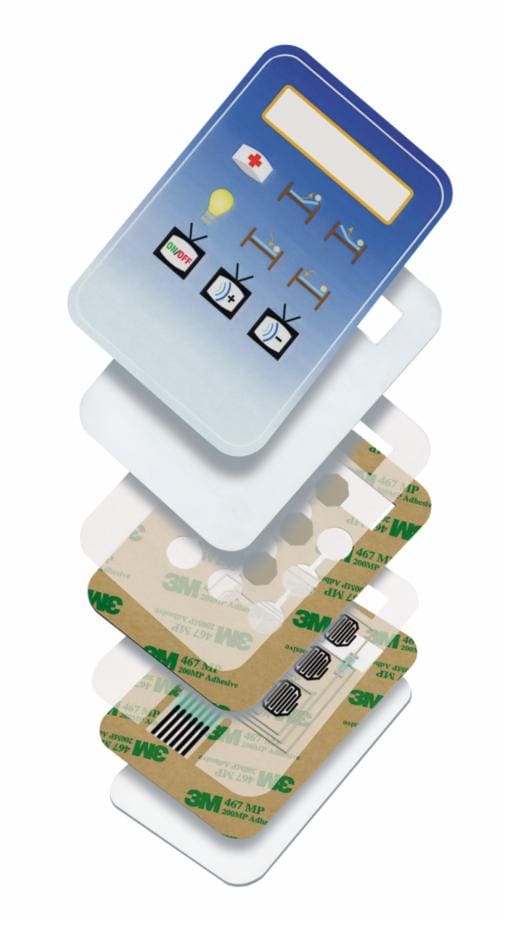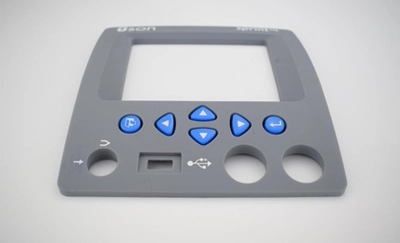Everything About Membrane layer Switch: A Comprehensive Guide for Beginners
Membrane buttons are vital parts in modern electronic devices, offering an one-of-a-kind user interface for customer interaction - membrane switch. Their split building, including overlays and conductive traces, supplies performance and toughness. Unlike traditional mechanical buttons, membrane buttons present a sleek layout and adjustable options. Recognizing their vital attributes and benefits can change product layout. The details of their application and design factors to consider call for additional exploration.
What Is a Membrane Switch?
A membrane layer button is a sort of electric switch that contains an adaptable membrane layer layered over a published motherboard. This style permits a small and smooth interface, frequently made use of in different electronic tools. Membrane buttons are frequently found in consumer appliances, clinical tools, and commercial machinery because of their resilience and resistance to ecological factors.The building and construction usually consists of numerous layers, such as visuals overlays and sticky backing, which supply responsive feedback and protect the wiring below. The procedure of a membrane layer button is launched when stress is put on the surface area, finishing an electrical circuit.These buttons are valued for their adaptability, enabling personalized layouts and published graphics that deal with particular interface. Their inconspicuous nature minimizes space needs, making them suitable for applications where standard buttons might not fit. Overall, membrane buttons offer a practical and visual option for contemporary electronic devices.
Key Parts of Membrane Switches
Membrane layer changes consist of several vital components that add to their functionality and performance. The leading layer, referred to as the overlay, offers the interface and is usually printed with icons or graphics. Under the overlay exists a spacer layer, which separates the conductive elements and stops inadvertent activation. The next crucial component is the graphic layer, which enhances appearances and assures the longevity of the design.Conductive traces, usually made from materials like silver or carbon, are printed on the circuit layer. When pressure is put on the overlay, these traces come right into contact, completing the circuit. Additionally, a backing layer uses structural assistance and can be made from products such as polyester or polycarbonate. With each other, these components produce a reputable, easy to use user interface suitable for different applications, from home appliances to industrial equipment. Recognizing these elements is important for any person thinking about membrane switch innovation.
How Membrane Layer Changes Job
Comprehending exactly how membrane layer switches feature is vital for valuing their prevalent use in numerous devices. A membrane switch operates via a series of layers, including a graphic overlay, spacer, and a circuit layer. When stress is used to the overlay, it compresses the spacer layer, enabling the circuit layer to make call and complete an electric circuit. This action sends a signal to the gadget, triggering a reaction, such as turning on a light or turning on a function.Membrane changes can be created with various attributes, including responsive feedback, backlighting, and custom-made graphics, boosting customer communication. Their construction enables a closed style, securing the inner elements from dust, dampness, and contaminants. This resilience makes them appropriate for diverse applications, from customer electronics to industrial equipment. Overall, the simpleness and effectiveness of membrane layer changes contribute to their popularity in contemporary technology.
Advantages of Membrane Layer Switches Mechanical Switches
While mechanical switches have long been a staple in lots of devices, membrane changes offer distinct benefits that make them increasingly appealing. One considerable advantage is their slim profile, permitting even more portable styles and better flexibility in item advancement. Additionally, membrane layer switches feature a consistent surface, which boosts aesthetic appeal and streamlines cleansing, making them suitable for settings where health is critical.Another advantage is their resistance to dust and wetness. Unlike mechanical switches, which can be jeopardized by environmental elements, membrane buttons supply a covered interface that protects against contaminants - membrane switch. Membrane switches commonly have a longer lifespan due to fewer moving parts, resulting in enhanced resilience and reliability.Cost-effectiveness is also a remarkable advantage, as membrane layer switches can be generated in bulk with reduced manufacturing expenses. These elements combine to place membrane switches as a practical option to typical mechanical options in different applications
Usual Applications of Membrane Changes
Membrane buttons are widely used in various industries, especially in customer electronic devices and commercial control panels. In consumer tools, they offer a sleek, straightforward interface, while in industrial settings, they enhance longevity and performance. Recognizing these applications highlights the convenience and usefulness of membrane switches in modern-day innovation.
Customer Electronic Devices Instruments
As consumer electronics proceed to advance, membrane layer buttons have come to be a preferred option for a range of gadgets because of their convenience and smooth design. These buttons are typically located in smart devices, tablet computers, and remotes, where room is limited and aesthetics issue. Their reduced account and personalized styles enable producers to develop user-friendly user interfaces that boost the general customer experience. In addition, membrane layer switches are commonly made use of in devices such as microwaves and coffee makers, providing intuitive control choices while resisting moisture and dust. The longevity and dependability of membrane layer switches over make them ideal for everyday consumer items, guaranteeing longevity and regular efficiency. Generally, their integration in consumer electronics shows a blend of functionality and contemporary layout.
Industrial Control Panels
The applications of membrane layer switches over extend beyond consumer electronics, finding considerable use in commercial control board. These switches are preferred for their toughness and resistance to harsh settings, making them ideal for producing and procedure control setups. They give a trusted interface for drivers to control equipment, display processes, and change setups. Membrane layer switches can be customized to suit details operational demands, integrating attributes like backlighting and responsive responses, improving individual experience. Their low-profile style permits integration into various tools, while their capacity to hold up against spills, dirt, and extreme temperature levels assurances long life. Generally, membrane buttons add to secure and reliable procedure in commercial applications, demonstrating their flexibility and efficiency in requiring atmospheres.
Factors To Consider for Designing Membrane Layer Switches
When designing membrane switches, choosing the best products is vital to assure durability and capability. In addition, comprehending layer configuration strategies can substantially influence the button's efficiency and customer experience. These considerations play a crucial function in developing efficient and trusted membrane layer button designs.
Material Option Importance
Material option plays a crucial duty in the design and functionality of membrane switches. The selected materials straight influence the switch's resilience, tactile action, and overall visual. Secret considerations consist of the substratum, which must supply architectural stability while enabling adaptability, and the graphic overlay, which needs to be resistant to wear and ecological factors. Conductive products should ensure dependable electric efficiency, while adhesives have to provide solid bonding without jeopardizing the button's operation. Additionally, compatibility with making processes and end-user settings is important; products need to stand up to differing temperatures, humidity levels, and chemical direct exposure. Inevitably, suitable product choice not only improves the membrane switch's efficiency but also adds to its longevity and user satisfaction, making it an essential aspect of the style procedure.

Layer Configuration Methods

Regularly Asked Inquiries
For How Long Do Membrane Switches Typically Last?
Membrane layer switches normally have a life expectancy of 1 to 5 million reference cycles, depending on usage and ecological problems. Elements such as layout high quality and operating regularity greatly influence their toughness and total efficiency durability.

Can Membrane Changes Be Personalized for Certain Layouts?
Membrane switches can undoubtedly be customized to accommodate details designs, enabling diverse forms, colors, and performances. This convenience enables makers to customize these switches to fulfill special visual and operational requirements successfully.
What Products Are Made Use Of in Membrane Layer Switch Building?
Membrane buttons are typically constructed using products such as polyester, polycarbonate, and glue layers. These products give versatility, durability, and resistance to ecological aspects, ensuring the buttons operate successfully in numerous applications and conditions.
Are Membrane Layer Switches Waterproof or Immune to Wetness?
Membrane switches can be developed to be moisture-resistant, making use of specialized finishings and products. Their water-proof capacities depend on building and construction top quality and certain applications, making it essential to analyze requirements for perfect performance in numerous environments.
Exactly How Are Membrane Layer Switches Over Fixed if Damaged?
Repairing damaged membrane switches over typically includes replacing the affected layer or circuit. Professionals might additionally apply conductive sticky or utilize specialized fixing kits, making sure functionality is brought back without complete replacement of the entire button setting up. Unlike conventional mechanical switches, membrane switches click to read offer a sleek layout and customizable alternatives. A membrane switch is a type of electric switch that is composed of an adaptable membrane layered over a printed circuit board. The operation of a membrane button is initiated when pressure is used to the surface area, completing an electric circuit.These switches are valued for their adaptability, enabling customized styles more information and printed graphics that cater to certain individual interfaces. While mechanical buttons have actually long been a staple in several tools, membrane layer changes offer unique advantages that make them progressively appealing. Membrane switches commonly have a longer lifespan due to less moving components, resulting in enhanced durability and reliability.Cost-effectiveness is likewise a noteworthy advantage, as membrane buttons can be created in mass with reduced manufacturing expenses.